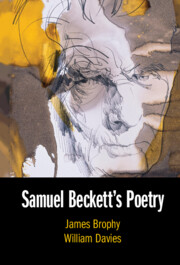Book contents
- Samuel Beckett’s Poetry
- Samuel Beckett’s Poetry
- Copyright page
- Contents
- Notes on Contributors
- Acknowledgements
- Abbreviations
- Introduction
- Chronology of Samuel Beckett’s Poetry
- Chapter 1 Weirdness and Dislocation in Beckett’s Early Poetry
- Chapter 2 Whole Fragments
- Chapter 3 Pre-echoing the Bones
- Chapter 4 ‘The Nucleus of a Living Poetic’
- Chapter 5 Beckett Growing Gnomic
- Chapter 6 Gender, Pronoun and Subject in ‘Poèmes 1937–1939’
- Chapter 7 The Missing Poème
- Chapter 8 Romanticism and Beckett’s Poetry
- 9 Romance under Strain in ‘Cascando’
- Chapter 10 Samuel Beckett’s Self-Translated Poems
- Chapter 11 Samuel Beckett’s Translations of Mexican Poetry
- Chapter 12 Beckett’s Poetry and the Radical Absence of the (War) Dead
- Chapter 13 Beckett’s Sound Sense
- Chapter 14 The Matter of Absence
- Chapter 15 ‘Mocked by a Tissue That May Not Serve’
- Chapter 16 Invoking Beckett
- Index
Chapter 3 - Pre-echoing the Bones
Samuel Beckett’s Early Poems and Translations as Transpositions
Published online by Cambridge University Press: 15 December 2022
- Samuel Beckett’s Poetry
- Samuel Beckett’s Poetry
- Copyright page
- Contents
- Notes on Contributors
- Acknowledgements
- Abbreviations
- Introduction
- Chronology of Samuel Beckett’s Poetry
- Chapter 1 Weirdness and Dislocation in Beckett’s Early Poetry
- Chapter 2 Whole Fragments
- Chapter 3 Pre-echoing the Bones
- Chapter 4 ‘The Nucleus of a Living Poetic’
- Chapter 5 Beckett Growing Gnomic
- Chapter 6 Gender, Pronoun and Subject in ‘Poèmes 1937–1939’
- Chapter 7 The Missing Poème
- Chapter 8 Romanticism and Beckett’s Poetry
- 9 Romance under Strain in ‘Cascando’
- Chapter 10 Samuel Beckett’s Self-Translated Poems
- Chapter 11 Samuel Beckett’s Translations of Mexican Poetry
- Chapter 12 Beckett’s Poetry and the Radical Absence of the (War) Dead
- Chapter 13 Beckett’s Sound Sense
- Chapter 14 The Matter of Absence
- Chapter 15 ‘Mocked by a Tissue That May Not Serve’
- Chapter 16 Invoking Beckett
- Index
Summary
In May 1930 the Surrealist writer Philippe Soupault suggested to Samuel Beckett that he team up with the poet Alfred Péron to translate into French a chapter from what was to become James Joyce’s final novel, Finnegans Wake (published in 1939). The collaboration with Péron can be seen as a starting point for Beckett’s development as a translator – a development that is interlaced with that of him as a writer. In a special Surrealist issue of This Quarter published in 1932, over a quarter of the volume’s two hundred texts were ‘rendered into English by Samuel Beckett’.1 Commissioned by Nancy Cunard, whose Hours Press had awarded Beckett’s poem ‘Whoroscope’ with a prize in 1930, he translated nineteen texts (prose, poetry, essays) for Negro: An Anthology (1934). This groundbreaking collection was conceived by Cunard as ‘no less than a comprehensive history of the cultural, social, political, and artistic achievements of the black people in the world’.2 Throughout the 1930s Beckett would also translate a great number of Surrealist texts into English for various issues of transition magazine. Clearly, Beckett was a productive translator in this formative decade, and although he himself may have regarded his translations as mere bread-and-butter exercises, their creative originality and the obvious effort he put into them suggest that they are centrally important to his oeuvre. I would argue, in fact, that they are to be considered as source texts in their own right. As Sinéad Mooney suggests, Beckett was interested in ‘broadening [through translation] the expansive possibilities of English’, an ambition he shared with many of his contemporaries.3 His translations are essential in understanding how his poetics evolved, and helped shape his approach to the self-translations by which he would go on to create, particularly after the Second World War, the famous redoubling of his oeuvre: Beckett’s self-translations are generally considered to be both dependent on and autonomous from their source texts. Similarly, adapting to his own goals the cultural context around him, Beckett in the 1930s produced translations that deserve to be seen in a fresh light: as experiments in transposing – both recreating source texts and creating independent target texts – rather than in merely translating texts.
- Type
- Chapter
- Information
- Samuel Beckett's Poetry , pp. 54 - 69Publisher: Cambridge University PressPrint publication year: 2022



